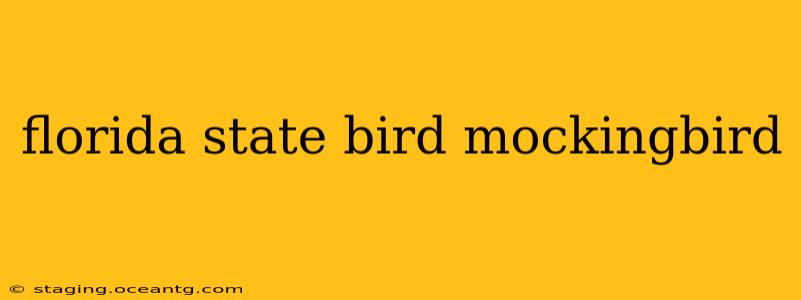Florida’s state bird, the Northern Mockingbird (Mimus polyglottos), is more than just a pretty face; it's a symbol of the state's vibrant ecosystem and resilient spirit. This captivating bird, with its distinctive song and bold personality, has earned its place as a cherished emblem of Florida. This comprehensive guide delves into everything you need to know about this remarkable avian resident.
What Makes the Northern Mockingbird Unique?
The Northern Mockingbird stands out for several reasons. Its most striking feature is its exceptional vocal abilities. It's renowned for its incredible mimicry, capable of reproducing the songs of other birds, as well as various other sounds from its environment, including car alarms and even human noises! This mimicry isn't just for show; it plays a crucial role in territorial defense and attracting mates. Beyond its vocal prowess, the Northern Mockingbird displays a bold and assertive nature, fearlessly defending its territory against intruders, regardless of size. This feistiness, combined with its melodious songs, makes it a captivating and memorable bird.
Why was the Northern Mockingbird Chosen as Florida's State Bird?
The Northern Mockingbird was officially designated as Florida's state bird in 1927. Its selection was likely influenced by several factors. Its widespread presence throughout the state makes it a familiar and beloved bird for Floridians. Its beautiful and varied song adds to the state's natural beauty and charm. Moreover, the bird's tenacious spirit and resilience mirror the spirit of the state itself.
What are the Physical Characteristics of the Northern Mockingbird?
The Northern Mockingbird is easily recognizable. It's a medium-sized bird, measuring approximately 9-11 inches in length. Its plumage is primarily a grayish-brown color, with white underparts and distinctive white wing patches. It has a long tail and a slightly curved beak, perfectly adapted for its omnivorous diet. Both males and females exhibit similar plumage, making it slightly more challenging to distinguish them based on appearance alone.
What does the Northern Mockingbird Eat?
The Northern Mockingbird is an opportunistic omnivore, meaning its diet includes both plant and animal matter. Its diet can vary depending on the season and availability of food sources. Insects form a significant part of their diet, particularly during the breeding season when they feed their young. They also consume fruits, berries, seeds, and occasionally small reptiles or amphibians. This adaptability allows them to thrive in various habitats across Florida.
What is the Northern Mockingbird's Habitat?
The Northern Mockingbird is highly adaptable and can be found in a variety of habitats throughout Florida. They prefer areas with some cover, such as shrubs, trees, and hedges, which provide protection from predators and nesting sites. They can be found in urban areas, suburban gardens, parks, and even woodlands, demonstrating their versatility and ability to coexist with humans.
How can I attract Northern Mockingbirds to my yard?
Attracting Northern Mockingbirds to your yard is relatively easy. Providing a source of water, like a bird bath, is crucial, especially during warmer months. Planting native shrubs and trees that provide berries and insects will also attract them. Keeping cats indoors will help ensure their safety. Avoid the use of pesticides, as these can harm both the birds and their food sources.
Are Northern Mockingbirds aggressive?
While generally not aggressive towards humans, Northern Mockingbirds are fiercely protective of their nests and territories. They will readily attack perceived threats, including larger birds and even humans who approach too closely to their nests. This aggressive behavior is primarily aimed at protecting their young.
What are the conservation status of Northern Mockingbirds?
The Northern Mockingbird is currently classified as a species of Least Concern by the IUCN Red List. Their wide distribution and adaptability contribute to their stable population numbers. However, habitat loss due to urbanization and deforestation remains a potential threat.
The Northern Mockingbird, Florida's state bird, is a symbol of song, resilience, and the vibrant natural beauty of the Sunshine State. Its distinctive song, bold personality, and adaptability make it a beloved and iconic part of Florida's natural heritage. Understanding and appreciating this remarkable bird helps us to cherish and protect its habitat for generations to come.
